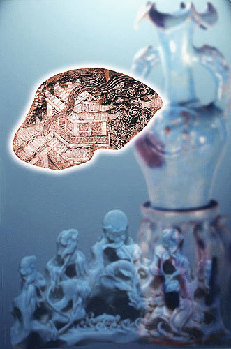Capital of the Yuan Dynasty (1271-1368)
Location: Beijing
Period: 1,267-1,368
Excavated in 1964
Significance: It has disclosed the layout, structure and features of the capital of the Yuan Dynasty.
 Introduction
Introduction
|

|
| Lacquer ware inlaid with mother of pearl: decorative object (left-up, length 22 cm); Porcelain amphora from Jun Kiln: decorative object (right, height 63 cm); Shadowy blue porcelain brush stand: writing utensil (left-bottom, height 11 cm) |
Capital Dadu of Yuan, site of the Upper Capital of the Yuan Dynasty, is on the northern bank of the
ShandianRiver, Zhenglan Banner, in Xilingol League of the Inner Mongolia Autonomous Region.
In the city's long history, the earliest walls were built in Zhongdu, capital of the Jin Dynasty. In 1267, Yuan rulers abandoned the site of the former Jin capital and constructed anew cityknown as Dadu (or the Upper Capital), centered in the Jin emperor's auxiliary palaces. Construction completed in 1276. The new city walls, with a perimeter of 30 kilometers, measured 21.6 meters at the base and 16.7 meters at the top. This was the embryonic form of present day Beijing.
The entire city area is square, consisting of the palace city, imperial city and outer city, which were set symmetrically along an axis. The palace city is built of bricks, with towers at the four corners. The major buildings are the Daming Hall and Da'an Pavilion. The imperial city surrounds the palace city, and is built of stone. The offices and mansions of the imperial family are located here. The outer city is completely built of earth. On the east and south sides were markets, residential areas and storehouses. In 1430, during the Ming Dynasty, it was abandoned.
In 1368, Zhu Yuanzhang, the first Ming emperor, attacked and captured the Yuan capital Dadu and established his new capital atNanjing. His son Zhu Di renamed Beiping (Northern Peace) Beijing (Northern Capital) in 1403, and in 1421 officially made it the capital of China. Dadu was then reduced to the rank of secondary capital after the dynasty made Beijing its capital. Every year, from April to July, emperors and ministers would not conduct administrative affairs and escape the heat of the summer here, thus making it another political, economic, military and cultural center.
